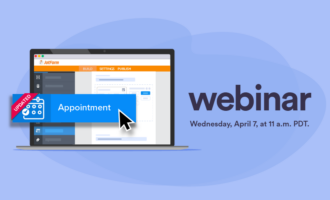Webinar marketing is an effective way to reach an even larger audience for lead generation purposes than you can with an in-person conference or seminar. And as most people spend more time at home during the COVID-19 pandemic, webinars are becoming an even more important marketing tool to enhance sales.
How can you leverage webinar marketing for your sales strategy? Read on to find out.
What is webinar marketing?
Webinar marketing focuses on using webinars to create brand awareness, generate leads, and increase sales. Webinars work for almost any topic, regardless of audience size. They are virtual events that can be formatted as a workshop, lecture, panel discussion, or large-scale meeting.
Webinars usually have a format similar to those used at in-person conferences, including keynote speakers, panel discussions, and a Q&A. They often focus on trends, issues, and solutions that impact a particular industry. In this way, webinar marketing builds thought leadership and credibility.
These meetings use video conference software for product or service demos that generate interest in the company without directly selling to attendees. Here are some ways to use webinar marketing to effectively fill your sales funnel.
Generate and drive engagement
Business owners sometimes take issue with webinars. They don’t always generate the in-person connection, rapport, and trust they seek with their prospective customers.
Nonetheless, webinars can deliver the engagement needed to influence your attendees’ purchase decisions. You can create an interactive experience with your virtual audience through chat rooms, live polls, and Q&A sessions that encourage them to share feedback and tell you what’s on their minds.
Some webinar platforms provide a live chat feature that lets you read comments, answer questions, debate objections, and send out audience announcements. Some webinar software even has audience attention and engagement indicators so you know who is paying attention and staying involved in your virtual conference.
Get leads through signups
Just as with registration for a physical conference, webinars are an opportunity to collect information you can use to qualify leads and follow up. People who have signed up are interested in your webinar topics, a signal they may need your product or service.
Many webinar software companies provide registration pages that you can add to your website. Software can also integrate with tools and platforms you already use to better manage all that lead data. For example, you can integrate many customer relationship management (CRM) systems with webinar registration tools to track attendee information and easily create follow-up email marketing campaigns to leverage those leads.
If you’re using Zoom for your webinars, you can use Jotform’s registration form templates and Zoom integration to simplify registration and collect the information you need. Jotform also has integrations with several CRM systems, including Salesforce, HubSpot, and Zoho CRM.
Reach a larger pool of leads
Since in-person conferences often require travel, many of your prospects were skipping live events even before the rise of COVID-19. Because webinars are virtual, participants don’t have to travel. This makes webinar marketing even more valuable when you’re targeting leads in different countries.
Many webinar software solutions like GoToWebinar and Zoom can be scaled to accommodate thousands of attendees with high-quality audio and video for your entire virtual presentation.
Repurpose webinars for additional traction
Sales opportunities extend well past attendee data collection and the live webinar broadcast. Your webinar content can be repackaged into other marketing and sales opportunities. This generates a higher return on investment and more traction by reaching others in your target audience who didn’t attend your original webinar.
You can follow up with those who signed up but didn’t attend to give them a downloadable webinar recording. You can also add webinar sound bites to your content marketing pieces. And you can publish this material on social media channels, as part of a summary blog post or as part of an email follow-up.
Keep the conversation going after the event with additional marketing efforts focused on webinar attendees. Send a follow-up survey as a call to action (CTA) to get more information about customer needs. Their feedback on what they learned from your webinar will help you to improve future webinars.
Optimize your efforts
A webinar marketing strategy, including detailed buyer personas, is an important component of your overall marketing efforts. Your plan should include how you’ll track results, particularly inbound leads and conversions by the sales team.
Formalizing your approach to webinars will help you plan more successful virtual marketing and sales events in the future. Your marketing and sales teams can collaborate on the agenda, format, and topics to align with attendee needs.















Send Comment: